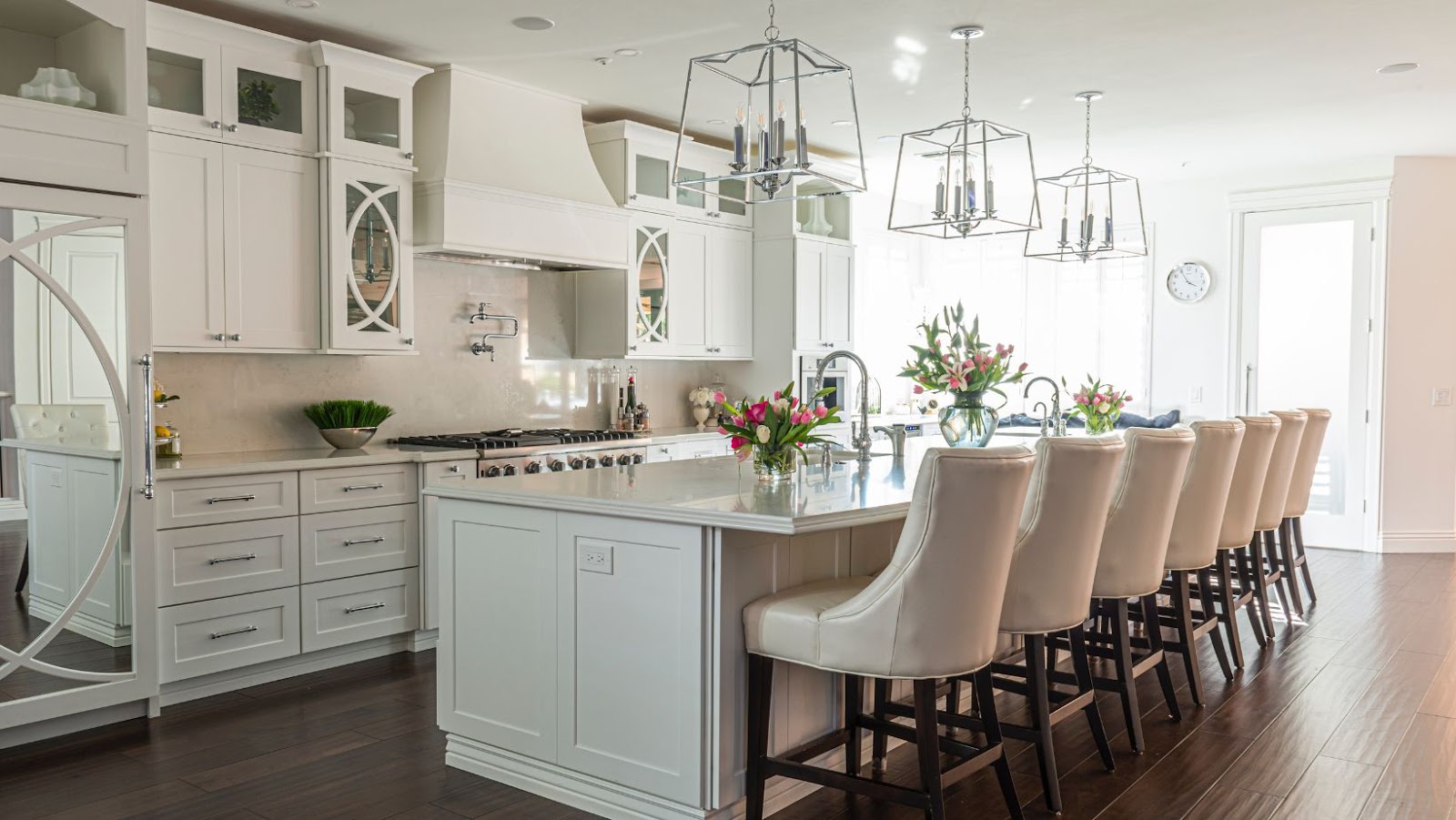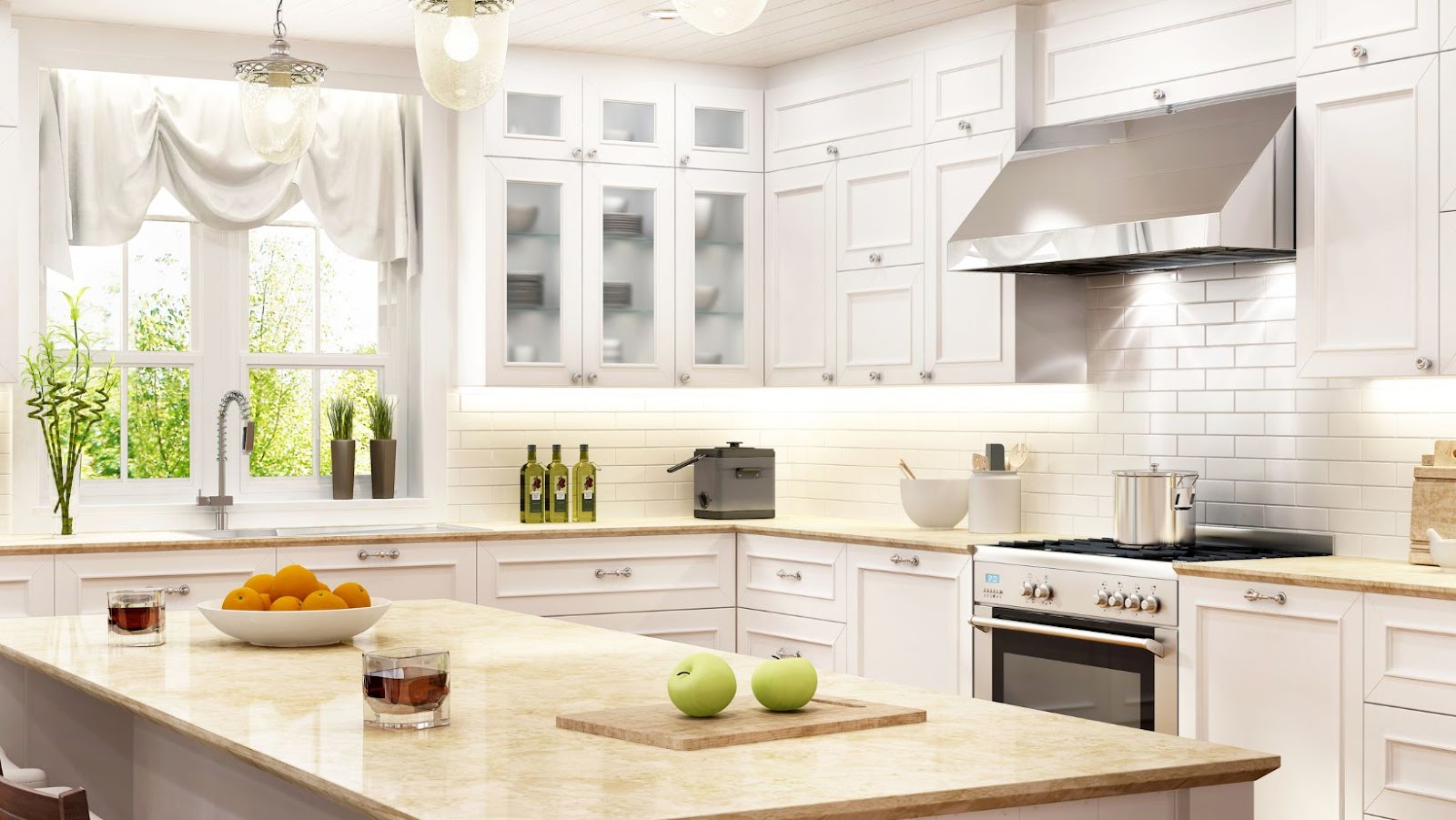How to Decide Whether a Kitchen Island or Peninsula is Right for your Kitchen

Choosing between a kitchen island or peninsula depends on various factors such as your kitchen layout, your lifestyle, and your cooking needs.
Kitchen Island vs Peninsula
Kitchen Layout: A kitchen island works best in a large open floor plan in the centre of the kitchen, while a peninsula is ideal for a smaller kitchen as it uses up less floor space.
Lifestyle: A kitchen island is ideal for those who love to entertain as it provides ample seating and counter space, while a peninsula is perfect for those who prefer to cook in privacy or require additional storage space.
Cooking needs: A kitchen island is perfect for those who like to cook elaborate meals as it provides ample workspace, while a peninsula is ideal for those who prefer a separate cooking area away from the main kitchen.
Ultimately, your decision should be based on your specific needs and personal preferences to ensure that your kitchen is not only functional but also stylish.
Pro tip: Consider consulting with a professional kitchen designer or contractor to help you decide which option is best for your kitchen.
Benefits of a Kitchen Island
Kitchen islands can be a great addition to any kitchen, providing a multi-functional and stylish solution to a range of cooking and storage needs. With its central location, a kitchen island can offer a place for barstool seating, preparation and cooking space, as well as plenty of storage.
Let’s take a closer look at the benefits of a kitchen island and how it can help to make your kitchen more efficient and stylish.
Increased Counter Space
Kitchen islands and peninsulas are popular options to increase counter space, provide storage, and add a functional yet stylish element to a kitchen.
Here are some benefits of a Kitchen Island:
1. Increased Counter Space: One of the most significant benefits of a kitchen island is that it provides additional counter space, which can be used for meal prep, serving, and dining.
2. Additional Storage: A kitchen island typically comes with additional cabinet and drawer space, making it ideal for storing cookware, utensils, and other kitchen essentials.
3. Aesthetically pleasing: A kitchen island adds an elegant touch to the kitchen and makes it look stylish and modern.
However, if you have limited space, a peninsula may be a better option as it provides the same benefits as a kitchen island but uses less floor space. A peninsula is essentially an extension of the existing countertop, connected to the wall or cabinets, extending out into the room. Choosing between a kitchen island and a peninsula depends on your personal preferences, kitchen layout, and available space.
More Storage Options
When it comes to choosing between a kitchen island or a peninsula, the decision ultimately comes down to what will work best in your kitchen. However, there are some benefits to using a kitchen island that you should consider.
More Storage Options: A kitchen island can provide additional storage space for your kitchen. You can include cabinets or drawers in the island to keep cookware, utensils, or pantry items. Some islands even have built-in shelving for cookbooks or decorative objects. By adding more storage, you can reduce kitchen clutter and make it easier to find everything you need while cooking.
On the other hand, a peninsula can also provide additional counter space and storage options. While it may not be as versatile as an island, a peninsula can work well in smaller kitchens where there may not be enough space for an island.
Ultimately, when deciding between a kitchen island or peninsula, it’s important to consider your personal preferences, kitchen size, and layout. With the right choice, you can transform your kitchen into a functional and inviting space.
Additional Seating
A kitchen island provides additional seating and serves as a functional centrepiece in your kitchen, but how do you decide whether a kitchen island or peninsula is right for your needs?
Benefits of a kitchen island: A kitchen island offers ample counter space for food preparation, cooking, and entertaining. It can also have built-in cabinets and drawers for storage and organisation, as well as a built-in sink for cleaning and washing.
Kitchen Island vs Peninsula: A peninsula is an extension of an existing kitchen counter that is connected to a wall or cabinetry, while an island is freestanding and can be accessed from all sides. A peninsula is a good choice if you have limited space or want to maintain an open floor plan. A kitchen island is ideal if you have a large kitchen and want a central focal point to gather around.
Pro tip: Consider the size of your kitchen, your specific needs, and how you plan to use the space before deciding whether a kitchen island or peninsula is right for you.
Benefits of a Kitchen Peninsula
If you are looking to create more counter space that is accessible from all sides, a kitchen peninsula is an excellent choice. A peninsula adds a work area right in the middle of the kitchen that can be used to prepare food or as a breakfast bar. Additionally, a peninsula takes up much less space than a kitchen island, so it’s ideal for kitchens that are limited in square footage.
Let’s explore some of the other advantages of installing a kitchen peninsula.
Better Traffic Flow
A kitchen peninsula can improve traffic flow and add functionality to your kitchen space, making it a popular alternative to a kitchen island.
Here are some benefits of a kitchen peninsula:
1. Better Traffic Flow: A kitchen peninsula allows for a more open layout, making it easier for people to move around the space. This is especially useful in smaller kitchens where an island might take up too much room.
2. Increased storage: A kitchen peninsula can be designed with storage underneath or cabinets and drawers at the sides, increasing your kitchen’s storage capacity.
3. Additional Seating: A peninsula can act as a breakfast bar, giving you additional seating options.
When deciding between a kitchen island or peninsula, consider the size of your kitchen, your storage needs, and your preferred layout. A kitchen professional can help you determine what’s best for your space.
Pro tip: A kitchen peninsula can be multifunctional, serving as a space for food preparation, a bar, or an informal dining area.
Easier to Incorporate into an existing kitchen
When it comes to kitchen design, a kitchen peninsula has several benefits over a kitchen island, making it easier to incorporate into an existing kitchen.
Unlike a kitchen island, a peninsula is connected to a wall or a line of cabinets, offering more flexibility for smaller kitchens while providing additional counter space and storage.
Here are a few tips to help you decide whether a kitchen island or peninsula is right for your kitchen:
Consider your kitchen layout and the available space. If you have a larger kitchen with an open-plan layout, a kitchen island might work better. However, if your kitchen is smaller or has a U-shaped layout, a peninsula might be a better fit.
Determine your storage and seating needs. A kitchen island offers more storage and can accommodate bar stools, while a peninsula provides counter space and works well as a breakfast nook.
Consult with a professional kitchen designer to help you make an informed decision about what will work best for your kitchen.
Pro tip: A kitchen peninsula can be a cost-effective alternative to a kitchen island while providing similar benefits.
Increased Privacy
A kitchen peninsula can provide increased privacy in your home, making it an attractive option for homeowners who value their personal space. Compared to a kitchen island, a peninsula is attached to your kitchen’s existing counters and cabinetry, creating a defined boundary to separate your cooking area from the rest of the house. This extension can also add more counter space and storage options without taking up additional floor space.
If you are looking to establish a visual separation between your kitchen and living area, a peninsula might be a better option than a kitchen island. Peninsulas can serve as a natural boundary, making it easier to balance room flow and creating additional visual appeal in your space. However, when deciding which option is right for you, you should consider factors such as available space, kitchen layout, and personal preferences.
Determine What Your Kitchen Needs
Whether you are renovating or building a new kitchen, one of the decisions you need to make is whether to add a kitchen island or a peninsula. Both of these options can add extra storage and work space to your kitchen, but there are some differences that may make one a better choice for your kitchen than the other.
Let’s take a look at the pros and cons of each option to make it easier for you to decide what your kitchen needs.
Assess Your Space
Before adding an island or a peninsula to your kitchen, It is essential to assess your space to determine which one will best fit your kitchen’s needs. The following pros and cons of each will help you make an informed decision based on your lifestyle.
Kitchen island: Perfect for larger kitchens, an island creates a free-standing workspace that adds countertop space and storage, seating, and cooking and entertaining areas. On the other hand, it occupies a lot of valuable floor space, making it difficult to navigate a small kitchen or work triangle efficiently.
Kitchen peninsula: This is an excellent space-saving option for small or narrow kitchens, providing an additional workspace or eating area while maintaining an open floor plan. A kitchen peninsula is easier to install than an island and usually costs less. However, It may limit your kitchen’s mobility while cooking due to its attachment to the main countertop.
Overall, Choose according to your kitchen’s size, layout, and functionality needs.
Consider Your Cooking Habits
When it comes to deciding between a kitchen island or peninsula, it is essential to consider your cooking habits and lifestyle to determine what your kitchen needs. Both options have unique benefits, and the right choice ultimately depends on your kitchen size, layout, and functionality requirements.
A kitchen island is perfect for those who love to cook and entertain as it provides ample counter space, storage solutions, and seating options. It is a stand-alone unit with access from all sides, making it easy to manoeuvre around while cooking. On the other hand, a peninsula is an extension of the existing countertop and is attached to one side of the kitchen. It is an excellent space-saving option for smaller kitchens and helps divide the kitchen from the living area.
Whether you choose a kitchen island or a peninsula, make sure it complements your kitchen’s overall design and enhances its functionality.
Determine Your Budget
Before deciding whether a kitchen island or peninsula is right for your kitchen, it’s essential to determine your budget as it will significantly influence your design options.
Here are some tips to help you determine your budget:
Begin by setting a minimum and maximum budget limit that you’re comfortable with.
Consider the cost of installation, appliances, finishes, and any additional features that you may want to incorporate into your kitchen.
Think about the long-term costs of maintenance and upkeep.
Be realistic and prioritise your needs, deciding which features are necessary and which ones you can afford to compromise on.
Once you have determined your budget limit, you can better evaluate your design options, determine what your kitchen needs, and which option, a kitchen island or peninsula, would work best for you.
Designing Your Kitchen Island or Peninsula
Designing and adding a kitchen island or peninsula to your kitchen can add an extra layer of style and functionality to your kitchen. But it can be hard to decide which one is right for your space.
Both kitchen islands and peninsulas come with their own unique benefits and drawbacks. In this article, we’ll look at the pros and cons of these two kitchen design options so you can decide which one is right for you.
Choose Your Countertop
Deciding between a kitchen island or a peninsula can be a tough call. One of the main factors that can help in making this decision is choosing the right countertop for the job.
When it comes to kitchen island countertops, there are a variety of choices to consider:
Granite: This natural stone material is durable, heat-resistant, and easy to clean, making it a great choice for a kitchen island countertop.
Marble: With its timeless beauty, marble is an excellent option if you’re going for a more elegant look. However, it requires a bit more maintenance and care than other materials.
Quartz: Highly durable, heat-resistant, and available in a wide variety of colours and patterns, quartz is a popular choice for kitchen island countertops.
As for peninsula countertops, many people opt for the same type of countertop as their main kitchen work surfaces, for a cohesive look. However, other options to consider include wood, stainless steel, and laminate.
Ultimately, the countertop you choose will depend on your personal taste, budget, and how you plan to use your kitchen island or peninsula.
Select Your Materials and Colours
Choosing the right materials and colours is crucial when designing your kitchen island or peninsula as it will not only affect the look of your kitchen but also its functionality.
Here are Some Tips on how to Select your Materials and Colours
Consider the style of your kitchen and choose materials and colours that complement it. For example, if you have a modern kitchen, you may want to go for sleek materials like stainless steel, while if you have a rustic kitchen, wood may be a better option.
Think about the durability of the materials you choose. Your island or peninsula will be used frequently, so it’s essential to select materials that can stand up to everyday wear and tear.
For countertops, go for non-porous materials like granite or quartz. They are easy to clean and maintain and can withstand scratches and stains.
When deciding between a kitchen island or peninsula, consider your kitchen’s layout and design. An island is perfect for an open floor plan, while a peninsula works better in a smaller kitchen with limited space.
Popular colours for islands and peninsulas include white, grey, blue, and green. Don’t be afraid to add a pop of colour to your design to make it more interesting or to match your home’s aesthetic.
Pro tip- While choosing materials and colours, remember to prioritise functionality and durability over aesthetics alone.
Decide on a Size and Shape
When deciding on a kitchen island or peninsula, it’s crucial to consider the size and shape of your kitchen to determine which option is right for you.
Here are a few things to keep in mind:
Size:
If you have a large kitchen, an island can be an excellent option since it will not take up too much space while offering ample storage and counter space. Conversely, if your kitchen is small, a peninsula would be more practical since it requires less space.
Shape:
The shape of your kitchen can also play a crucial role in deciding between an island or peninsula. A straight peninsula would work best in a kitchen with a straight wall layout, while an L-shaped peninsula would complement an L-shaped kitchen. An island works well in any kitchen shape, but make sure to consider the best size and shape to optimise space in your kitchen.
Ultimately, the choice between a kitchen island or peninsula will depend on your kitchen’s size, shape, and your family’s lifestyle, so consider these factors before deciding.
Frequently Asked Questions About Kitchen Islands and Peninsulas
When designing a kitchen, choosing between a kitchen island and peninsula can be a difficult decision. Both options have their own sets of advantages and drawbacks. Understanding the differences between a kitchen island and peninsula can help you make an informed decision.
This article will answer some of the most commonly asked questions about kitchen islands and peninsulas.
What’s the Average Size of a Kitchen Island?
The average size of a kitchen island is about 3 feet by 6 feet for a standard rectangular island design. However, kitchen islands can range in size from as small as 2 feet by 4 feet to as large as 4 feet by 10 feet or more, depending on the size of the kitchen and the intended use of the island.
When deciding whether a kitchen island or peninsula is right for your kitchen, consider these factors:
Space: A peninsula may be a better option for smaller kitchens with limited space, as it can provide counter and storage space without taking up as much floor space as an island.
Function: Consider how you plan to use the space. A kitchen island is ideal for food prep and cooking, while a peninsula is better suited for casual dining and entertaining.
Traffic flow: Think about how the island or peninsula will affect traffic flow in the kitchen. For larger kitchens with multiple entry points, an island can create a natural traffic flow pattern. For smaller kitchens, a peninsula may be a better choice to avoid creating a bottleneck that disrupts the flow of traffic through the space.
Pro Tip: Take measurements of your kitchen and make a cardboard cut-out of the size of the island or peninsula you are considering to get a better sense of how it will fit in the space.
How Much Will a Kitchen Island or Peninsula Cost?
Kitchen islands and peninsulas can vary in price depending on several factors such as the size, materials used, features, and whether it is a DIY or contracted construction. As a rough estimate, a basic 6-foot-by-3-foot kitchen island can cost anywhere from $1,000 to $5,000 depending on the materials used. Larger, high-end islands with extra features can cost between $10,000 – $30,000.
Here are a few Factors to Keep in Mind
Materials: The type of material you choose, whether it’s granite, marble, or quartz, can significantly impact the final cost.
DIY vs contracted construction: A DIY approach might save money, but only if you have the skills and expertise necessary to install an island on your own.
Island vs Peninsula: When deciding between a kitchen island and a peninsula, a peninsula is often the cheaper option as it requires fewer materials.
Keep these factors in mind when considering whether to install a kitchen island or peninsula in your home.
How do I Install a Kitchen Island or Peninsula?
Installing a kitchen island or peninsula can transform your cooking and entertaining space. However, deciding between the two can be challenging.
A kitchen island is a freestanding structure in the centre of the kitchen, allowing for easy access from all sides. A peninsula, on the other hand, is attached to one of the kitchen walls, creating an L-shape in the kitchen.
Here are some factors to consider before installing:
- Space – consider the size of your kitchen and where the island or peninsula will fit in.
- Workflow – think about how you use your kitchen and how an island or peninsula could improve the flow.
- Purpose – determine the main function of your island or peninsula, whether it’s for food preparation or dining and entertaining.
Once you’ve decided on your preference, follow these steps:
- Plan your layout and design.
- Assemble your island or peninsula using the manufacturer’s instructions.
- Secure the structure to the floor and attach any necessary electrical or plumbing fixtures.
- Paint or stain the structure to match your kitchen’s decor.
- Enjoy your new and improved kitchen space!
Can I put a Sink or a Cooktop on my Island or Peninsula?
Yes, it is possible to put a sink or cooktop in your kitchen island or peninsula, but it depends on your individual kitchen layout and plumbing and electrical capabilities.
When deciding between a kitchen island versus a peninsula, consider the following factors:
1. Space: If you have limited space, a peninsula may be a better option since it takes up less floor space than an island.
2. Traffic flow: If you have a large kitchen with multiple entrances, a peninsula may be less disruptive to traffic flow than an island.
3. Functionality: If you need extra storage and counter space, an island may be the better choice. If you need extra seating, a peninsula may be more practical.
4. Plumbing and electrical needs: If you want to install a sink or cooktop, you’ll need to ensure that your plumbing and electrical systems can accommodate them in your chosen location.
By weighing these factors, you can decide whether a kitchen island or peninsula is right for your kitchen.
Conclusion – Summary of Benefits and Considerations for Kitchen Islands and Peninsulas
In summary, there are several benefits and considerations to keep in mind when deciding between a kitchen island and a peninsula for your kitchen.
Kitchen Islands:
- Provide ample storage and counter space for prep work and entertaining
- Can be a focal point of the kitchen, adding visual interest and design appeal
- Require sufficient floor space for circulation and may not be practical in smaller kitchens
Kitchen Peninsulas:
- Can be a space-saving alternative to a kitchen island, especially in smaller kitchens
- Can provide a natural division between the kitchen and adjacent living or dining areas
- May not offer as much counter or storage space as a kitchen island
Consider your kitchen’s layout, size, and intended use when deciding between a kitchen island or peninsula. Ultimately, choosing the right kitchen feature depends on your personal preferences, needs, and budget.






